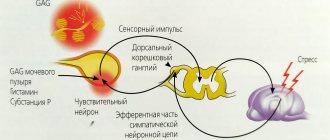Nature of the disease
First you need to understand the nature of the disease. Distemper in dogs is a viral pathology that can affect both individual organs and entire systems. Typically, the causative agent of plague is closely related to the human causative agent of measles. As numerous studies show, distemper affects not only dogs, but also other predators. But is a person susceptible to developing this disease?
The causative agent of Carré disease is a virus containing RNA. An animal infected with a virus releases the virus in its saliva. This is how the virus spreads. It is worth noting that this kind of virus can be released not only by sick individuals, but also by those who were previously sick. Distemper is contagious over a long period of time. Moreover, the owner of the animal can be the carrier of the virus. Without knowing it, the owner himself can infect the dog. How? When a person moves, the virus gets onto clothes and shoes. However, despite the fact that people can act as carriers of the virus, a person can never become infected with distemper from a sick dog. This applies to panleukopia and swine fever. Therefore, the fears of many owners are absolutely meaningless.
The disease and its causative agent
The causative agent of the disease is the parvovirus Feline Panleukopenia, whose diameter is 20-25 nm. With panleukopenia, damage to the internal organs of the animal occurs. The virus attacks the lymphatic system, bone marrow, and gastrointestinal tract.
The number of leukocytes in the cat's blood decreases. The old ones die, and new ones are not produced. This weakens the body’s protective properties, and the “green light” comes on for the virus.
The lifespan of the plague pathogen in the external environment reaches 1 year. At the same time, all its pathogenic properties are preserved.
— Feline Panleukopenia has become attached...
Routes of infection
The causes of Carre's disease are various. A predisposing factor to the development of this disease is inappropriate housing rules, in particular, poor nutrition. In addition, infectious diseases can be a starting point.
The pathogen can enter the animal’s body in several ways. The first of them is the respiratory tract, the second is the digestive tract. A dog can become infected through direct contact with a sick animal. Moreover, personal hygiene items can cause infection.
In some cases, distemper can be transmitted from mother to puppy through mother's milk. The virus transmitted from an unvaccinated adult to a puppy reduces the chances of getting rid of the disease.
Most children between the ages of 3 and 12 months become infected with plague. It is important to remember that timely contact with a specialist increases the chances of recovery. It is important to remember that only a veterinarian can identify distemper and initiate treatment.
Diagnostics and tests
A serological blood test can determine the presence of antibodies. In addition to blood, the skin, mucous membranes and skin of the paw pads can also be tested for the presence of antibodies. X-rays can be used to determine whether an infected dog has pneumonia if the disease is in the respiratory tract.
Express test
To accelerate the detection of the virus, a special test was created that can identify canine distemper viral antigen in the conjunctiva, urine, serum or plasma taken for analysis with a high degree of accuracy. This method allows you to prevent the death of the animal.
Clinical blood test
Canine distemper in dogs is diagnosed using a biochemical test of blood and urine, thanks to which the doctor detects a lack of lymphocytes, white blood cells that protect the immune system in the initial stages of the disease. This allows us to draw a conclusion about the pet's problem.
Clinical forms of the disease
So, the following clinical forms are characteristic of plague:
- Nervous form. It is represented by muscle contractions, spasms and aggressive behavior.
- Pulmonary form, in particular cough, inflammation of lymphoid tissue.
- The intestinal form is a skin rash.
Depending on the course, plague can be fulminant, acute or chronic. The fulminant nature is characterized by the absence of obvious symptoms of the disease and rapid death. The hyperacute course is characterized by an increase in temperature and a deterioration in appetite. As a rule, such a course exhausts the animal’s body in a few days. In acute cases, all obvious signs of the disease are noted.
Typically, the lightning form ends in the death of the pet, since the doctor can no longer help the animal.
Disease in pregnant cats and cerebellar hypoplasia in kittens
You already know that the virus prefers to attack rapidly dividing cells of lymphoid tissue. And this is extremely dangerous for the same kittens, since they are developing the reticuloendothelial and immune systems of the body. If this process is disrupted, nothing good will await your pet in the future; complications will be severe (even autoimmune diseases). But it is much worse when the virus infects the tissues and organs of an unborn kitten. The cat itself, as we said above, may not suffer at all. But for her kittens it ends badly. As a rule, if your pregnant pet had leukopenia, she will give birth to a dead litter . But this, by the way, is not the worst outcome.
Pregnancy in cats lasts 62-67 days. If infection occurs in the last two weeks before birth, the virus, for some reason, most often affects the brain of the fetus . Specifically, the cerebellum. It is still unclear why this happens, because the brain is protected by the blood-brain barrier, and therefore it would be much easier for the virus to choose another “refuge.”
The fact remains that it is the brain that is damaged, the consequences of which are extremely unpleasant.
Kittens are born already having coordination problems . At first it is not too noticeable. But as soon as they begin to actively crawl, it is easy to see stiffness, inconsistency and severe inhibition of their movements. This happens due to improper development of the cerebellum and partial degradation of its tissues. When palpating the kitten’s muscles, it turns out that they are flaccid and as if “boiled”; the animal’s muscles are often shaken by severe trembling. Practice shows that at least 90% of prenatally infected pets remain blind . They often experience convulsions. Oddly enough, kittens do not suffer from a lack of appetite: they eat well and grow no worse than their healthy peers.
Sometimes these animals adapt well to their condition, but over time, the symptoms of cerebellar damage may worsen. If the pet can use the tray normally (they have good learning ability) and at least move around somehow, then with minimal care they will live no worse than healthy animals.
By the way, what happens when distemper develops in nursing cats? In this case, cerebellar hypoplasia does not threaten her offspring, but kittens are 100% likely to develop the usual form of panleukopenia, since the virus can be excreted from the body along with milk.
Does vaccinating pregnant cats cause hypoplasia?
Yes, this may well happen, but only in case of gross violation of vaccination rules. More precisely, in situations where a pregnant cat is vaccinated with a live vaccine (made from a weakened pathogen).
Remember that this drug should not be used on pregnant or lactating cats, as well as kittens less than four weeks old!
In cases where it is necessary to vaccinate a pet that is in an “interesting” position, use a “dead” vaccine , which is made from a deactivated (killed) virus. It is completely safe and even theoretically cannot cause disease.
In addition, even with routine vaccination of adult cats, it is strongly recommended to check the level of antibodies in their blood plasma. Vaccination is given only if the indicators are below normal.
How to treat?
To this day, doctors have not been able to invent an effective cure for Carré's disease. Because of this, therapy is based on several methods. First of all, treatment has the goal of maintaining the general tone of the animal. A person must understand that the treatment process itself is characterized by duration. Since each animal is an individual system, treatment is prescribed in accordance with the characteristics of the body.
If the disease is detected at an early stage, treatment consists of serum and gamma globulin administration. After this, the veterinarian prescribes antibiotics and a vitamin complex. The owner must approach the treatment of the dog responsibly and not self-medicate, as such an approach can hasten the onset of death. In addition to medications, proper nutrition plays an important role. It helps normalize the condition. The diet should accompany the dog even after the disease has subsided. You can cope with distemper and alleviate the animal’s condition with the help of folk remedies. Traditional treatment is represented by herbal decoctions. You can normalize the functioning of the nervous system with the help of motherwort.
Treatment, feeding during the recovery period
The veterinary clinic should prescribe complex treatment, including etiotropic drugs, and also prescribe symptomatic drugs to relieve symptoms. A medicine, a sodium chloride solution, should be administered intravenously to reduce dehydration and relieve intoxication.
The course of treatment must include:
- Antibiotic therapy - to kill bacteria in the microflora. The immune system of an infected pet practically does not work and all the bacteria that enter the stomach are activated. To neutralize them, antibiotics must be used. The dose and combination of drugs must be selected by a doctor; as a rule, they are administered intravenously.
- Antibodies that are contained in serums and globulins. They are used to neutralize viruses. It should be borne in mind that they are effective only at the onset of the disease and as a preventive measure.
- Drugs that stimulate the immune system, such as interferon.
- Salts leave the body along with vomiting, so it should be stopped. Metoclopramide helps suppress vomiting; you can also use Cerucal.
- Distemper is accompanied by severe abdominal pain and fever. You can alleviate the animal's suffering by using painkillers and antipyretics, and you should also give antispasmodics.
- During this period, the animal also needs vitamins and iron supplements.
Feeding during this period of illness is difficult, since the sick pet is in an exhausted state and refuses food. There is no need to force people to take food and water. He should be fed parenterally (through a vein).
When the animal develops an appetite, you should take care of proper nutrition. His diet should consist of five feedings a day. Food should be pureed, warm and light. Fermented milk products and puree soups with boiled minced meat will be useful.
Feline distemper, treatment with vodka
Judging by reviews from forums about folk remedies, treating a furry friend with vodka at home also gives results and brings positive results.
Note! Treatment with vodka should be resorted to if the cat has been infected for only a couple of days and the disease has not yet had time to spread throughout the body.
If vodka really helps an animal, the result will be visible immediately after 24 hours.
The proportions are as follows: one tablespoon of vodka, mixed with egg yolk. This mixture must be fed to the animal 2 - 3 times a day, one spoon at a time.
Preventive actions
The best way to prevent the development of plague is vaccination. Today there are several methods of vaccination. Only a veterinarian can choose the appropriate option. Veterinarians are of the opinion that a dog vaccinated before 3 months does not retain immunity. However, the animal must be vaccinated in any case. The first time was in childhood, and the second time was in adulthood. Another preventive measure is to prevent unwanted contact with stray dogs, since a dog can get distemper from them.
In fact, the world knows several types of distemper, which exclusively affects one category of animals. Typically, feline distemper is not dangerous for dogs and people, since it is not transmitted. This also applies to swine fever. It is transmitted directly from one individual to another in only one category.
As is known, Crimean disease causes problems with the nervous system in dogs. In addition, Carré's disease causes pneumonia and fever. As noted above, a person should not be afraid of Carré’s disease.
Symptoms - how does distemper manifest in dogs?
The first sign of infection is discharge from the eyes and nose. Afterwards, the pet begins to develop a fever, vomiting, and coughing. Appetite disappears, even lethargic states are possible. When the nervous system is damaged, muscle cramps and circular behavior occur. If timely treatment does not occur, paralysis develops.
The main symptoms often develop in the following order:
- watery and then purulent discharge in the eye and nose area;
- high (up to 40 °C) temperature in the first 2 days of symptoms;
- photophobia, redness of the mucous membranes of the eyes, possible tousled hair;
- cough and lethargy, apathy, drowsiness, lack of appetite;
- vomiting, diarrhea, difficulty breathing and (rarely) hardening of the paw pads.
Dehydration may develop as a result of the above symptoms. Paralysis is the extreme, most severe stage of the disease. Even if your pet recovers, the infection can be transmitted for another 2 weeks.
Is the disease contagious to humans? The answer is no. Canine distemper is not transmitted to humans.
The risk group includes pets with reduced immunity. Even a vaccinated dog can get sick due to immunodeficiency. Typically, such situations occur due to insufficient care from the owner. But it is possible that the immune system may be weakened due to other previous diseases or surgery.
Host contribution
A positive trend and positive outcome of the disease depends on many factors, the main one of which is human participation. The owner must give the sick animal appropriate care and attention. In order for the chances of recovery to be maximum, a person must take measures to clean his eyes. There are also certain requirements for the premises. The room must have a dry and warm microclimate.
How to avoid getting infected with the plague?
Immunity against the disease is provided by a vaccine, which is administered three times at intervals of two weeks. There is another type of vaccine that uses a live plague pathogen. It is administered once, and it allows a person not to get sick for up to six months.
Quarantine is declared in places where plague cases are detected. Symptoms of the disease appear very quickly - from two to 24 hours. If you have not been vaccinated, but have had contact with infected people, be sure to consult a doctor.
Article on the topic
"Diary of the Plague Year." Excerpt from the historical novel by Daniel Defoe










